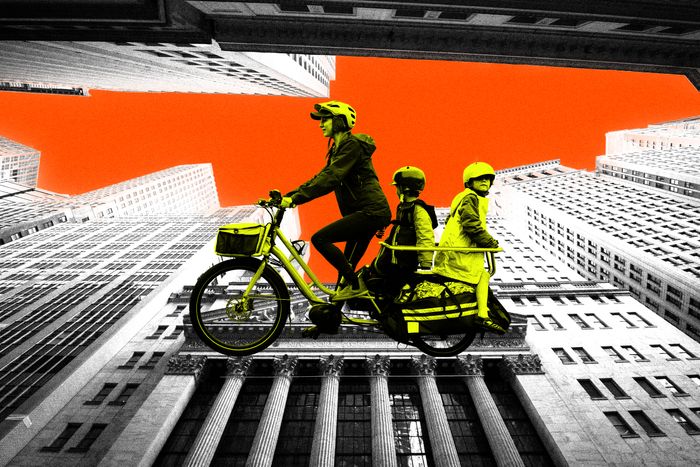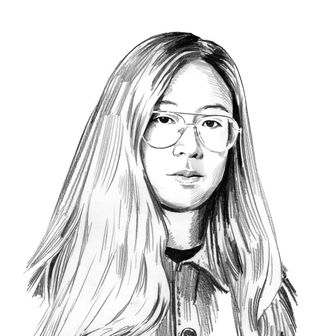
Life in the Financial District is one of those enduring New York curiosities. It’s been decades since the neighborhood was the beating heart of finance, which would desert it after happy hour, but why live that close to the Charging Bull if you could help it? The population hovered around 13,000 in the 1990s but has since ballooned to nearly 70,000 as the neighborhood was transformed by a tax-incentivized crop of luxury developments and office conversions. As that happened, a narrative emerged in real-estate trend pieces: Living in Fidi (a term coined by a developer in 2007) was actually great. The neighborhood offered way more than fast-casual lunch spots and a strangely enduring Ann Taylor Loft that opened after 9/11. And families — well, they loved it the most. It seemed impossible, somehow. Was it true or was it a conspiracy between the New York Post and Harry Macklowe?
I started to find out by posting to a Facebook group for parents in the neighborhood and was a little shocked by just how eager people were to talk. Nearly a dozen parents responded, ready to expound on the neighborhood’s merits. Alex Gordon, a finance lawyer who came to Fidi in 2003 in search of cheap rent, properly loves it. The feeling has only grown since he and his wife had a child, he says, and as more stuff opens. Of particular note? Complete Playground, a 40,000-square-foot indoor play space on Broad Street. “That’s been really good for the neighborhood,” Gordon says. “You definitely see more kids with more strollers now.” (He’s not imagining it: Paige Murphy, an administrator at Léman Manhattan Preparatory, a private school on Morris Street, said that enrollment has grown from 50 to 700 students since 2005.)
Bill Fisher, the CEO of an online business school called Quantic, is a more recent arrival. He came here from the West Coast two years ago and agrees it’s been a great place to live with young children. The transportation is plentiful, including the nearby ferry, the schools are good, and there are parks if you’re willing to walk a bit. It’s also cheaper than a lot of other places in Manhattan. “When I told people we were moving there, they were confused why I wasn’t moving to Park Slope or whatever,” Fisher says. “I think it’s a very poorly understood neighborhood.”
But some residents say they like Fidi precisely because it’s not misunderstood. “I actually like that it’s a blank slate of humanity that doesn’t exist anywhere else in New York,” Shaun Surething, a queer hairstylist who co-owns Seagull Hair Salon in the West Village, tells me. After spending all day talking about gender and politics with his clients, he says the “cultural void” of the Financial District comes as a relief. “I wanted a place to live where it was kind of flattened so I could have a place to decompress.” (This view of the culture was more or less confirmed, even if accidentally, by a server on the cobblestoned block of Stone Street that feels like a perennial Oktoberfest. While residents do stop in, the customer base is still mostly tourists and office workers — a tour group comes through “every three hours,” he says in an impressively cheerful tone.)
In both cases — parents and overstimulated stylists alike — it’s the frictionlessness that neighborhoods with a Whole Foods and dense transit options offer that people seem to like. Like Downtown Brooklyn and Kips Bay, two similarly vibeless neighborhoods, Fidi is safe, convenient, and you can get on a train to essentially anywhere if you want to do something more than order in and exercise.
This isn’t to say the neighborhood lacks charm, Surething adds. “One could make a case that it’s arguably the most beautiful and decadent part of the city.” He moved to the neighborhood in 2021 with his husband and loves the wide-open plazas and public art (not the Bull). Surething says the restaurant waits are shorter compared to places uptown and things are just bigger in general, like Conwell Coffee Hall (a coffee shop and cocktail bar that’s also a front for Sleep No More) in an old Art Deco building.
Which is maybe closer to what some of the neighborhood’s old-timers loved about it to begin with. Before there was Blue Bottle, there was Esther Regelson, who arrived in 1983 after taking over her sister’s rent-stabilized lease. She lives in one of the few low-rise tenements left on Washington Street, now a rarity among the block’s glass skyscrapers. “When I had just moved, I walked to Broadway and there was not a soul in sight,” she says. She liked the eccentricities of the area. “There were cobblestoned streets, there was a little flavor.” But she’s seen a lot of the small businesses that actually made the area more livable and neighborhood-y — florists, hardware shops, small pharmacies, chocolate shops — close down over the years. “I don’t think people realize what they could have had,” Regelson says. Maybe it goes without saying she hates the term Fidi. “I think it’s pretentious.”


